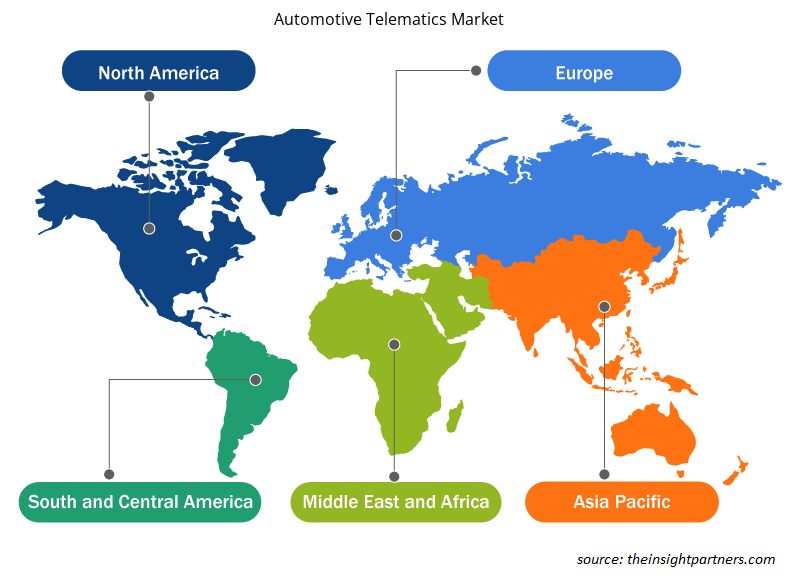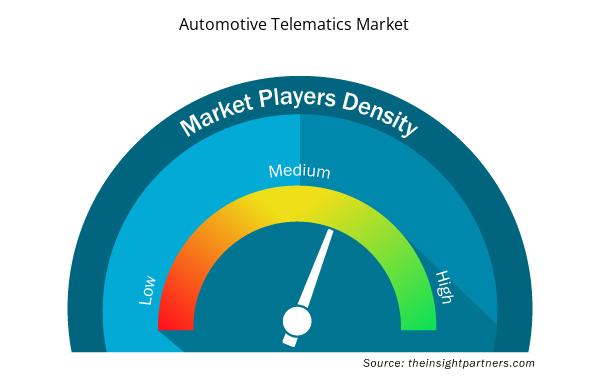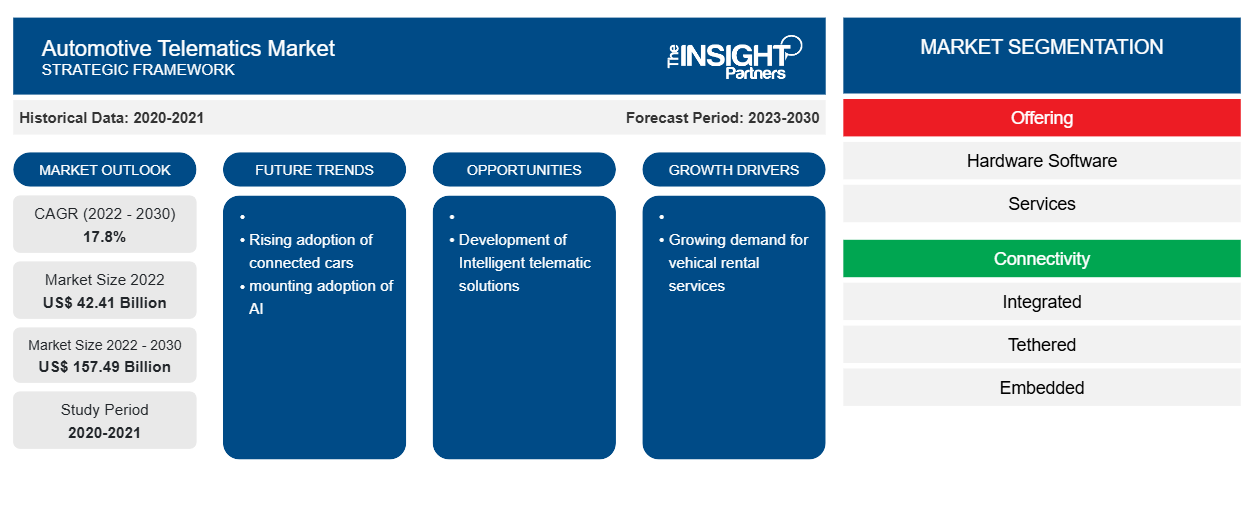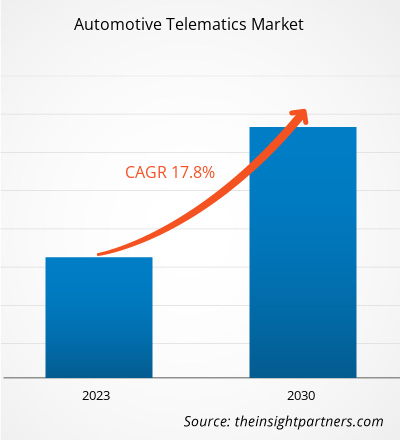[研究报告] 汽车远程信息处理市场在 2022 年达到 424.1097 亿美元,预计 2022 年至 2030 年的复合年增长率为 17.8%。预计 2030 年将达到 1574.8512 亿美元。
分析师观点:
全球汽车远程信息处理市场 已细分为五个主要区域:北美、欧洲、亚太地区、中东和非洲以及南美。随着全球联网汽车的兴起,豪华汽车产量和销量不断增加,推动了全球汽车远程信息处理市场的发展。根据欧洲汽车制造商协会的报告,2022 年汽车产量将达到约 8540 万辆,与 2021 年相比增长 5.7%。
汽车远程信息处理包括使用 V2X 通信来改善道路安全和实时跟踪、提高系统效率和提供更好移动性的 GPS 设备、软件或系统。它使用通过短距离通信和点对点和车对车通信收集的数据来分析其他车辆、骑车人、行人和其他人的行为并检测潜在风险。技术进步和对安全性和便利性的日益关注是北美汽车远程信息处理市场的主要驱动因素。根据汽车研究中心的数据,2022 年汽车行业在全球经济中的总规模约为 2.8 万亿美元,占全球经济 GDP 的 3%。北美汽车行业每年的汽车销售额超过 5000 亿美元。根据美国全国汽车经销商协会 (NADA) 2022 年的报告,它在美国雇佣了超过 170 万人。根据同一消息来源,汽车生态系统(包括直接、间接和诱导增加值)每年在美国创造超过 1 万亿美元的收入,占美国 GDP 的 4.9%。美国在北美汽车远程信息处理市场处于领先地位。人们对减轻温室气体排放和控制碳足迹的日益关注对欧洲汽车远程信息处理市场产生了积极影响。电信基础设施的日益进步和汽车行业的技术不断发展也推动了欧洲联网汽车市场的发展。德国、法国和英国为欧洲汽车远程信息处理市场做出了重大贡献。根据欧洲汽车制造商协会 (ACEA) 的数据,欧洲和北美占全球汽车总产量的约 34.6%。 CARTRACK、Teletrac Navman、Geotab、MiX Telematics、TomTom Telematics BV、Trimble Inc.、Harman International Industries Inc. 和 Omnitracs 是全球汽车远程信息处理市场的主要市场参与者。除了这些参与者之外,还有其他几家参与者也在全球范围内运作,逐年贡献了可观的收入份额。
市场概况:
汽车远程信息处理结合了硬件和软件解决方案,包括 GPS 系统、车载车辆诊断、无线远程信息处理设备和其他解决方案,以传输记录和车辆数据。远程信息处理设备控制多个参数,例如位置、速度、维护要求和服务。汽车远程信息处理是一种借助 GPS 技术监控车辆(例如汽车、汽车设备、卡车和其他资产)的系统。全球范围内内置先进远程信息处理系统的汽车销售和生产的增加正在推动市场增长。根据欧洲汽车制造商协会的报告,2022 年全球汽车产量约为 8540 万辆,比 2021 年增长 5.7%。
定制此报告以满足您的需求
您可以免费定制任何报告,包括本报告的部分内容、国家级分析、Excel 数据包,以及为初创企业和大学提供优惠和折扣
- 获取此报告的关键市场趋势。这个免费样品将包括数据分析,从市场趋势到估计和预测。
市场驱动因素:
汽车租赁服务需求不断增长
汽车远程信息处理解决方案广泛安装在租赁车辆上,以跟踪油耗和车辆位置并为驾驶员提供安全保障。全球范围内汽车租赁业务的日益普及是汽车远程信息处理市场增长的主要驱动因素。根据 Insight Partners 的数据,2022 年豪华车租赁业务的价值约为 295 亿美元。2022 年,美国汽车租赁市场的收入为 563 亿美元,比 2021 年增长了 9.8%。此类租赁业务在全球范围内为采用远程信息处理解决方案创造了巨大的需求。在汽车租赁中,远程信息处理用于车队管理——主要用于车辆的跟踪和诊断。该技术还实现了汽车共享服务,使公司能够跟踪车辆使用情况并相应地向客户收费。车队远程信息处理提供了丰富的资产信息。借助 GPS 跟踪和车载诊断读取功能,远程信息处理可直接从资产收集数据,提供有关资产使用情况、驾驶员行为、燃油消耗和诊断故障代码 (DTC) 的详细信息。终端用户越来越多地采用汽车租赁服务,推动了全球汽车远程信息处理市场的增长。
节段分析:
根据产品,全球汽车远程信息处理市场分为硬件、软件和服务。其中,由于对车辆跟踪设备、物流和运输的需求不断增长,硬件部分在 2022 年占据了最大份额。2022 年,车辆和设备等净运输资产价值为 10.68 万亿美元。公共部门运输拥有价值约 5.96 万亿美元,私营部门拥有近 4.71 万亿美元。与 2021 年相比,2022 年运输资产、基础设施和其他设备的价值增长了 6.5%。全球运输和物流行业的这种增长为汽车远程信息处理市场中的汽车硬件部分创造了巨大的需求。
区域分析:
由于原始汽车制造商的需求不断增长,加拿大的汽车远程信息处理市场正在温和增长。加拿大有五家主要汽车制造商:福特汽车、菲亚特克莱斯勒、丰田、通用汽车和本田。这些公司需要多种汽车远程信息处理设备来为加拿大消费者制造最终车辆。这些领先的参与者正在扩大业务并提高工厂的生产能力,以满足国内汽车需求。2020 年 11 月,通用汽车计划在加拿大投资超过 7.3 亿美元,以扩建其皮卡制造设施。这些皮卡集成了 OEM 制造的 GPS 跟踪设备。此外,2023 年 6 月,通用汽车计划在加拿大多伦多投资超过 2.8 亿美元建造重型商用 IC 发动机重型皮卡。加拿大 OEM 的投资增加推动了汽车远程信息处理市场的增长。
汽车产量和销量的增长对加拿大汽车齿轮市场做出了巨大贡献。根据 2022 年的 OICA 报告,加拿大生产了超过 122 万辆汽车,比 2021 年增长了 10%。因此,在预测期内,商用车销量的增长和该国汽车工厂的不断扩张可能会刺激该国汽车远程信息处理市场的增长。
关键球员分析:
Verizon Communications Inc.、Geotab Inc.、Omnitracs、Samsara Inc.、Lytx Inc.、TomTom International BV、Harman International、Denso Corp 和 Valeo 是汽车远程信息处理市场的主要参与者。
汽车远程信息处理市场区域洞察
Insight Partners 的分析师已详尽解释了预测期内影响汽车远程信息处理市场的区域趋势和因素。本节还讨论了北美、欧洲、亚太地区、中东和非洲以及南美和中美洲的汽车远程信息处理市场细分和地理位置。

- 获取汽车远程信息处理市场的区域特定数据
汽车远程信息处理市场报告范围
| 报告属性 | 细节 |
|---|---|
| 2022 年市场规模 | 424.1亿美元 |
| 2030 年的市场规模 | 1574.9亿美元 |
| 全球复合年增长率(2022 - 2030 年) | 17.8% |
| 史料 | 2020-2021 |
| 预测期 | 2023-2030 |
| 涵盖的领域 | 通过奉献
|
| 覆盖地区和国家 | 北美
|
| 市场领导者和主要公司简介 |
|
汽车远程信息处理市场参与者密度:了解其对业务动态的影响
汽车远程信息处理市场正在快速增长,这得益于终端用户需求的不断增长,这些需求源于消费者偏好的不断变化、技术进步以及对产品优势的认识不断提高等因素。随着需求的增加,企业正在扩大其产品范围,进行创新以满足消费者的需求,并利用新兴趋势,从而进一步推动市场增长。
市场参与者密度是指在特定市场或行业内运营的企业或公司的分布情况。它表明在给定市场空间中,相对于其规模或总市场价值,有多少竞争对手(市场参与者)存在。
在汽车远程信息处理市场运营的主要公司有:
- 威瑞森通信公司
- Geotab 公司
- 奥米特拉克斯有限公司
- 轮回股份有限公司
- Motive 技术公司
免责声明:上面列出的公司没有按照任何特定顺序排列。

- 了解汽车远程信息处理市场的主要参与者概况
最新动态:
全球汽车远程信息处理市场中的公司高度采用无机和有机策略,例如产品发布。以下列出了汽车远程信息处理市场主要参与者的一些最新发展:
年
|
消息
|
地区
|
2022 年 3 月 | 全球物联网 (IoT) 解决方案提供商 ORBCOMM Inc. 宣布,它已为其数据驱动的卡车远程信息处理解决方案增加了新的功能增强,以提高车队、驾驶员及其客户的可视性、效率、安全性和体验。 | 北美 |
2021 年 5 月 | Lytx 是一家领先的机器视觉和人工智能视频远程信息处理提供商,其车载技术作为工厂安装选项在所有 2022 年款或更新款沃尔沃卡车上提供。该技术的集成强化了沃尔沃卡车“零事故”愿景以及为客户提供最新安全功能的承诺。 | 北美 |
- 历史分析(2 年)、基准年、预测(7 年)及复合年增长率
- PEST 和 SWOT 分析
- 市场规模价值/数量 - 全球、区域、国家
- 行业和竞争格局
- Excel 数据集



Report Coverage
Revenue forecast, Company Analysis, Industry landscape, Growth factors, and Trends

Segment Covered
This text is related
to segments covered.

Regional Scope
North America, Europe, Asia Pacific, Middle East & Africa, South & Central America

Country Scope
This text is related
to country scope.
常见问题
The rising adoption of the vehicle rental business across the globe drives the automotive telematics market. The car rental market in the US generated US$ 56.3 billion in revenue in 2022, which increased by 9.8% compared to 2021. Such rental businesses have created massive demand for the adoption of telematics solutions around the globe.
The rise in AI in the transition to intelligent telematics gateways and 5G technologies is expected to create ample opportunity for the growth of the automotive telematics market. These gateways are embedded with advanced, powerful processors, such as multi-core CPUs, and can handle high volumes of data using AI.
Verizon Communications Inc., Geotab Inc., Omnitracs, Samsara Inc., Lytx Inc., TomTom International BV, Harman International, Denso Corp, and Valeo are the key market players operating in the global automotive telematics market.
IoT-enabled telematic devices optimize customer services and enhance vehicle maintenance management. With an IoT-integrated automotive telematics platform, communication and data retrieval become easy via smartphone applications and help in condition monitoring of the vehicle.
Asia Pacific dominated the global automotive telematics market in 2022 and is projected to continue its dominance during the forecast period. Major countries such as China and India are actively promoting electric mobility, providing incentives for electric vehicle adoption, and supporting the development of charging infrastructure.
Trends and growth analysis reports related to Automotive and Transportation : READ MORE..
The List of Companies - Automotive Telematics Market
- Verizon Communication Inc.
- Geotab Inc.
- Omitracs LLC
- Samsara Inc.
- Motive Technologies Inc.
- Lytx Inc.
- Zonar Systems Inc.
- ORBCOMM Inc.
- Trimble Inc.
- Skybitz Inc.
The Insight Partners performs research in 4 major stages: Data Collection & Secondary Research, Primary Research, Data Analysis and Data Triangulation & Final Review.
- Data Collection and Secondary Research:
As a market research and consulting firm operating from a decade, we have published and advised several client across the globe. First step for any study will start with an assessment of currently available data and insights from existing reports. Further, historical and current market information is collected from Investor Presentations, Annual Reports, SEC Filings, etc., and other information related to company’s performance and market positioning are gathered from Paid Databases (Factiva, Hoovers, and Reuters) and various other publications available in public domain.
Several associations trade associates, technical forums, institutes, societies and organization are accessed to gain technical as well as market related insights through their publications such as research papers, blogs and press releases related to the studies are referred to get cues about the market. Further, white papers, journals, magazines, and other news articles published in last 3 years are scrutinized and analyzed to understand the current market trends.
- Primary Research:
The primarily interview analysis comprise of data obtained from industry participants interview and answers to survey questions gathered by in-house primary team.
For primary research, interviews are conducted with industry experts/CEOs/Marketing Managers/VPs/Subject Matter Experts from both demand and supply side to get a 360-degree view of the market. The primary team conducts several interviews based on the complexity of the markets to understand the various market trends and dynamics which makes research more credible and precise.
A typical research interview fulfils the following functions:
- Provides first-hand information on the market size, market trends, growth trends, competitive landscape, and outlook
- Validates and strengthens in-house secondary research findings
- Develops the analysis team’s expertise and market understanding
Primary research involves email interactions and telephone interviews for each market, category, segment, and sub-segment across geographies. The participants who typically take part in such a process include, but are not limited to:
- Industry participants: VPs, business development managers, market intelligence managers and national sales managers
- Outside experts: Valuation experts, research analysts and key opinion leaders specializing in the electronics and semiconductor industry.
Below is the breakup of our primary respondents by company, designation, and region:

Once we receive the confirmation from primary research sources or primary respondents, we finalize the base year market estimation and forecast the data as per the macroeconomic and microeconomic factors assessed during data collection.
- Data Analysis:
Once data is validated through both secondary as well as primary respondents, we finalize the market estimations by hypothesis formulation and factor analysis at regional and country level.
- Macro-Economic Factor Analysis:
We analyse macroeconomic indicators such the gross domestic product (GDP), increase in the demand for goods and services across industries, technological advancement, regional economic growth, governmental policies, the influence of COVID-19, PEST analysis, and other aspects. This analysis aids in setting benchmarks for various nations/regions and approximating market splits. Additionally, the general trend of the aforementioned components aid in determining the market's development possibilities.
- Country Level Data:
Various factors that are especially aligned to the country are taken into account to determine the market size for a certain area and country, including the presence of vendors, such as headquarters and offices, the country's GDP, demand patterns, and industry growth. To comprehend the market dynamics for the nation, a number of growth variables, inhibitors, application areas, and current market trends are researched. The aforementioned elements aid in determining the country's overall market's growth potential.
- Company Profile:
The “Table of Contents” is formulated by listing and analyzing more than 25 - 30 companies operating in the market ecosystem across geographies. However, we profile only 10 companies as a standard practice in our syndicate reports. These 10 companies comprise leading, emerging, and regional players. Nonetheless, our analysis is not restricted to the 10 listed companies, we also analyze other companies present in the market to develop a holistic view and understand the prevailing trends. The “Company Profiles” section in the report covers key facts, business description, products & services, financial information, SWOT analysis, and key developments. The financial information presented is extracted from the annual reports and official documents of the publicly listed companies. Upon collecting the information for the sections of respective companies, we verify them via various primary sources and then compile the data in respective company profiles. The company level information helps us in deriving the base number as well as in forecasting the market size.
- Developing Base Number:
Aggregation of sales statistics (2020-2022) and macro-economic factor, and other secondary and primary research insights are utilized to arrive at base number and related market shares for 2022. The data gaps are identified in this step and relevant market data is analyzed, collected from paid primary interviews or databases. On finalizing the base year market size, forecasts are developed on the basis of macro-economic, industry and market growth factors and company level analysis.
- Data Triangulation and Final Review:
The market findings and base year market size calculations are validated from supply as well as demand side. Demand side validations are based on macro-economic factor analysis and benchmarks for respective regions and countries. In case of supply side validations, revenues of major companies are estimated (in case not available) based on industry benchmark, approximate number of employees, product portfolio, and primary interviews revenues are gathered. Further revenue from target product/service segment is assessed to avoid overshooting of market statistics. In case of heavy deviations between supply and demand side values, all thes steps are repeated to achieve synchronization.
We follow an iterative model, wherein we share our research findings with Subject Matter Experts (SME’s) and Key Opinion Leaders (KOLs) until consensus view of the market is not formulated – this model negates any drastic deviation in the opinions of experts. Only validated and universally acceptable research findings are quoted in our reports.
We have important check points that we use to validate our research findings – which we call – data triangulation, where we validate the information, we generate from secondary sources with primary interviews and then we re-validate with our internal data bases and Subject matter experts. This comprehensive model enables us to deliver high quality, reliable data in shortest possible time.


 获取此报告的免费样本
获取此报告的免费样本